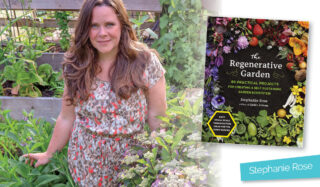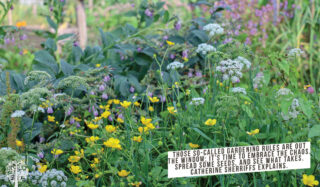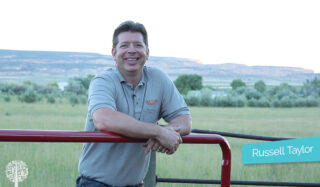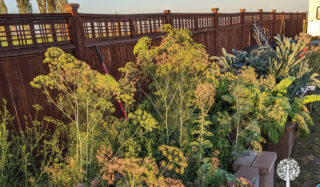For many years, gardeners have known the rules: start seeds indoors and nurture them until they’re ready to be planted outside. Don’t forget to harden them off! And for the love of God, space them properly in tidy rows or forget any harvests. Now, imagine not doing any of that, grabbing a packet of seeds and casting them haphazardly throughout the garden space. Relinquish all control and see what sprouts. Is your chest feeling tight? Welcome to Chaos Gardening.
“Chaos is meant to be disruptive. It’s meant to make you uncomfortable, and that’s how we learn best,” says award-winning author and gardener Stephanie Rose. “I don’t feel that gardening needs to be so planned and so maintained.”
Rose should know. She’s an herbalist, permaculturist, and the author of several books, including two of my personal favorites, Garden Alchemy and The Regenerative Garden. Both books guide gardeners through working with nature and restoring the planet while growing productive, sustainable home garden spaces that don’t require much work. Rose’s love for regenerative gardening jumps off her pages, and after our recent video chat, I can confirm her passion is contagious. Rose has a way of making you want to do better, and it helps that she offers concrete and easy ways to achieve that goal in her books. During our talk, she tells me about her recent lawn adventures at her new home in Vancouver, BC, where she’s defying all of the traditional rules of growing grass. Rose didn’t prepare the land or buy truckloads of new soil. Instead, she pulled up the existing pieces of grass, planted 1,500 bulbs, covered them back up, and tossed a wildflower turf alternative over some compost mixed with sand.

Credit: Eduardo Cristo
“It is complete chaos,” she admits. “And I did it two months before the seed packets said I could do this.”
She’s at nature’s mercy and is perfectly fine with that. Rose is expecting some losses. Whatever grows is meant to be there; anything that doesn’t would never have survived, anyway. She’s open to learning from the plants and creating her space based on what they tell her.
“If we have too much ego going into chaos gardening, then that’s where we will not succeed,” she says. “If we go in with humility and an open mind to learn, then we will be able to grow as gardeners as our gardens grow with us.”
Garden Trends
Chaos gardening is all the rage, trending on TikTok and Instagram. Videos of ‘chaos carrots’ popping up in random garden spots are getting over a million views. The new generation of gardeners is keen on ditching the traditional growing rules and the constant work typically associated with tending plants. Rose believes today’s gardeners understand they must correct many mistakes from the past, and that’s why the topic is trending. They want to toss carrot seeds and wildflower seed bombs into bare garden spaces and see what happens. They don’t want structured gardens with tall plants in the back, shorter ones in the front, and dyed mulch between them. They’re ready to move away from the perfectly manicured lawns that are weed-free yet dying of thirst.

Credit: Stephanie Rose
“The generation coming up sees this as lawful evil because it’s not supportive of our environment,” Rose says. “It is so much labor, and they’re thinking about a whole generation of people who didn’t garden because they could see how much work it was.”
The Trade-Off
Chaos gardening is the definition of low-maintenance. Rose recommends researching the plants that do well in your region and buying seeds that speak to you. Cast the seeds widely and often, forgetting about spacing completely. Water and see what grows.
“You’re going to have far lower germination rates than you would if you followed [directions] and had done it in a greenhouse and set all the plants out,” she says. “However, seeds are inexpensive. Your time is valuable. Your energy is valuable, so you’re doing a bit of a trade-off here.”
As the plants grow, you will notice some varieties thriving more than others. When they establish, Rose recommends digging up anything that doesn’t fit the space properly and placing it elsewhere in the garden. It’s as simple as that, and that is regenerative gardening. Or, should we say, chaos gardening?
“Well, it’s just a different name for the same thing, right?” Rose explains. “But I love where this is coming from because this is a whole new generation embracing the idea of chaos as something positive.”
Sowing Chaos
Russell Taylor, vice president of Live Earth Products and international Certified Crop Advisor, turned to chaos gardening as an act of desperation.

“I had an area in front of my house and planted some boxwoods, but they died. And then I planted a small pink Japonise willow, and that died,” he recalls. “I just couldn’t get anything to grow. I had to have something green. I cleaned out the seed bin, threw it out in front of the house, and what grew is what grew.”
Today, he has a beautiful self-propagating area of zinnias and salvia growing outside his front door. That’s what nature intended for his space, and Taylor has learned to listen and embrace the chaos. He also experiments with vegetable crops and fresh herbs, randomly sprinkling radish, spinach, arugula, kale, and cabbage seeds throughout his raised beds. Strawberries roam around the base of his asparagus plants. He planted dill ten years ago and hasn’t replanted it since; the herb just won’t quit! Taylor suggests watching these more invasive crops to give others a fighting chance, thinning as needed.

Russell’s volunteer dill plants hard at work
“Carrots, for example, whether it’s chaos-seeded or planned, if they’re too crowded, they don’t get the proper nutrients,” he says. “So, you thin them. One of the keys is to say, ‘We sowed some chaos. Now let’s get some organization, so these things aren’t competing too much.’”
Taylor is a soil guy, so he stresses the importance of building living earth to allow the plants to reach their full potential. He also recommends understanding seed habits, especially if you live in a small space where porch and patio varieties are better than anything indeterminate.
Small and Indoor Spaces
Rose sees no reason why people living in small spaces shouldn’t scatter seeds in a pot and watch them grow. She also encourages indoor gardeners to get in on the chaos on their windowsills or wall planters. Culinary herbs are an excellent start, but we can take things further by regrowing food from kitchen scraps in water. These crops may not be as productive as the ones growing outdoors, but something is always better than nothing.
“Great mistakes are how we learn,” she says. “The biggest thing to watch out for [with chaos gardening] is not being open to what the lessons are.”

Credit: Stephanie Rose, Garden Therapy
Nature’s Lead
Luckily, nature’s lessons are everywhere in our gardens, meadows, and forests. Crowded plants die back in natural settings, allowing others to intermingle and thrive. Dense woodland plantings provide living mulch, preventing soil erosion and water evaporation. They also offer habitat to beneficial insects and other wildlife. It’s chaotic, regenerative, and wonderful.
So, don’t be afraid. Gather seeds you love and scatter them throughout the garden like nobody’s watching. Don’t worry about spacing, density, losses, or any other great mistakes you might make. See what grows, be excited about nature’s surprises, and learn from them. Most of all, let loose and embrace the chaos.